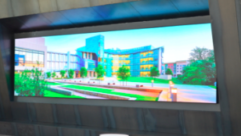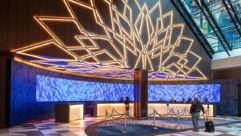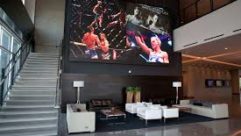
Technology Showcase: LCD Lobby Displays
Dec 1, 2008 12:00 PM,
By Jay Ankeney
From kiosks to videowalls, the selection of hospitality flatscreens is growing.

Hyundai IT D400ML/D460ML
Lobby displays are the warm and fuzzy siblings of the expanding digital-signage family. Instead of blaring out advertising, flashing directional commands, or hyping the latest gotta-get-’em item at a desperate sale price, lobby displays usually present information you actually want to know. They beckon you warmly to hotel registration desks, gently empower your self-service efforts to purchase tickets and other merchandise, or tell you when the next presentation is due to start at a theater, cineplex, or museum. While most digital signage roars, lobby displays usually purr.
As lobby displays become ever more ubiquitous, LCD flatpanels have come to predominate. This is partially due to their lower cost in smaller panel sizes, but also because of their historical resistance to burn-in when the same logo or branded icon has to stay in the same place on the screen 24 hours a day. In addition, the energy efficiency of LCDs has proved to be more green, and while home users are only starting to become aware of the energy requirements of their entertainment screens, facilities managers are increasingly monitoring the kilowattage it takes to keep their lobby displays shining.
The Environmental Protection Agency (EPA) estimates that a 42in. LCD display can consume less than half the energy required by the equivalent plasma screen, especially if the plasma set only goes into standby mode when shut off. To encourage conservation, on Nov. 1, the EPA began awarding Energy Star labels to displays that are up to 30 percent more energy efficient than conventional models. With soaring costs per kilowatt hour, that can start to make a difference if your lobby displays are on 24/7.
You’d have to be as blind as a bat not to have noticed that digital signage is exploding. Although figures for lobby displays by themselves are hard to break out, the sales of commercial LCDs are doing very well. According to DisplaySearch — a worldwide leader in market research, consulting, and conferences on the display supply chain and display-related industries — sales of LCD public displays that are more than 26in. will grow from $447,967,000 in 2006 to $2,889,671,000 in 2011. This represents an increase in unit shipments of 196,926,000 displays in 2006 to 2,527,536,000 in 2011 with 0.04 percent of them being more than 100in.
Since they are intended for well-lit public areas, most lobby displays are expected to put out a luminance intensity of at least 600 candela per square meter (cd/m2) or nits of brightness and a robust contrast ratio that would not be required for home-theater installations.
Many lobby displays can be configured in multipanel videowalls since they are intended to catch the eye in the background of a public environment. Or in more intimate settings, they can stand alone, often mounted in areas where decisions have to be made. Although they all boast VESA-compliant mounting patterns so they can be hung on walls, many LCD panels are designed to sit on registration counters or self-supporting pedestals. This gives them the look more of a compliant butler than the commanding majordomo presence associated with most other digital-signage displays.
To get signals into a lobby display, multiple connection options on the back of the chassis are usually provided — including HDMI, DVI, BNC (component/composite), and VGA ports, along with an RS-232c port to remotely control the display’s functions. Content can be provided over a network via IP, or from built-in media players and various card readers. Of course, to keep innocent fingers from messing with the look of the display, most front-panel controls are locked out.
In recent years, the capability of being able to choose portrait (vertical) or landscape (horizontal) orientation has become increasingly appealing. While back in the days of relatively square (4×3) CRT screens this wasn’t a big factor, the rectangular (16×9) faces of modern LCD panels have encouraged many lobby-display designers to stand them on their heads.
Technology Showcase: LCD Lobby Displays
Dec 1, 2008 12:00 PM,
By Jay Ankeney
From kiosks to videowalls, the selection of hospitality flatscreens is growing.
Up until about three years ago, the mercury in the cold cathode fluorescent lamp (CCFL) light sources used in most LCD panels were prone to settling, so when the display was placed in a vertical portrait mode, there would be unevenness in the backlight of the panel. But advances in lamp technology have overcome this effect, and most newer CCFLs have only up to half the mercury of conventional fluorescents.
However, despite their name, CCFLs can get very hot with prolonged use. One major factor that differentiates commercial LCD panels intended for lobby displays from the LCD TVs in homes or hotel rooms is concern for the heat buildup when the unit is intended for 24/7 operation. Some manufacturers have begun hanging the internal components from independent cage structures that isolate the panels from the enclosing cabinets, while others have come up with ultra-quiet fan configurations to move more air through the display than convection currents can transport. The even more recent trend to use LEDs as illumination sources will obviate this concern further and provide even greater energy efficiency. And when organic light-emitting diode (OLED) technology comes of age, heat concerns will be relegated to tales told around the campfire by gray-bearded engineers.
Finally, since drawing the attention of passersby without intruding upon their space is the goal of a lobby display, many of the latest technologies for innovative image presentation are being adopted for their screens. This includes multiple pictures that present themselves from different angles as the viewer walks by, touchscreen surfaces, and passive or autostereoscopic 3D displays that can reach out to onlookers even when they are not wearing 3D glasses.
Lobby displays are often referred to as “hospitality displays,” and their goal is to say: “Hi. How Are You? Can I help you a) find your way? b) find what you are looking for? c) get you where need to go when you need to be there? or d) discover something that you did not know was available in this area?” Here is a look at some of the more innovative designs for these gentle ambassadors that help us find what we sometimes don’t even know we are seeking.
Akira designs and assembles its own line of indoor and outdoor commercial LCD products right in its northern California facilities. The company’s ALM Series (46in., 52in., 70in., and 82in.) open-frame LCD panels for single-screen or videowall use can have either a touchscreen or autostereoscopic 3D overlay. The 3D mode uses a parallax barrier system that currently boasts 12 views (with 21-plus views in development), letting multiple observers experience Z-axis space simultaneously while standing up to roughly 32ft. away to experience an almost 10ft.-deep 3D image. Akira’s Interactive Touch Display/eWhite Board transforms viewers into interactive manipulators of content. Using the most advanced IR image sensors allows Akira’s eWhite Board to provide an accurate and natural writing experience with a 10-millisecond response time on even the largest screen. Akira also offers an extra-widescreen format Pana Series that introduces a unique display format for the digital-signage arena with its panoramic viewing. If the lobby area is outdoors, Akira’s Outlook Series features 46in. and 52in. outdoor LCD displays for high-brightness installation sites that work with the ambient light to create a brighter display to accommodate the most highly lit sites.

AOC 2230Fm
AOC has introduced its new HD3 technology with the launch of its 2230Fm display, which is described as “a new breed of multifunctional high-definition display technology.” AOC’s 2230Fm 22in. monitor includes both a digital 4-1 card reader and USB inputs so you can view video, pictures, and music without a PC. With a unique ring design for onscreen display adjustments, AOC’s 2230Fm claims a dynamic contrast ratio of 20,000:1; 2-millisecond response time; and dynamic color boost that allows you to isolate a section of the screen and manipulate the color for that section only. You don’t need a separate content player or external PC with the 2230Fm to put content on its screen. You simply load a video, welcome sign, or any other digital lobby information content onto a memory device, plug it into the display, and use AOC’s proprietary, user-friendly menu and remote control to experience the display PC-free. The 2230Fm is PC/Windows- or Mac-content ready. It comes with an analog VGA D-sub or DVI port and in a 360-degree glossy, piano-black finish.
Technology Showcase: LCD Lobby Displays
Dec 1, 2008 12:00 PM,
By Jay Ankeney
From kiosks to videowalls, the selection of hospitality flatscreens is growing.
Founded in 1982 as a custom touchscreen manufacturer, CyberTouch offers more than 300 standard touchscreens and open-frame, wall-mount, panel-mount, and desktop touchscreen LCD monitors. The OrionAV line from CyberTouch is a series of touchscreen LCD monitors that enable operation and control of any computer application with a simple touch. Resistive technology allows activation with a touch of a finger, gloved hand, or stylus. The touch surface is protected by a chemical- and abrasion-resistant polycarbonate overlay. Offered in 16:9 widescreen and standard 4:3 formats, OrionAV ranges from 15in. to 46in. diagonal. The displays are VESA-compatible and may be mounted on a wall or placed on a table, shelf, or stand. Optional loudspeakers are available. CyberTouch’s OrionAV can also come with either a Mac mini or mini PC attached.
The FlexScan T1502 and T1501 15in. touchscreen monitors from Eizo Nanao Technologies are equipped with an analog-resistive touchpanel that offers a fast touch response, long touch life, and low energy consumption for intimate and economy-minded lobby displays. The T1502 offers its touch interface through a USB port connection, while the T1501 offers its touch interface through an RS-232C serial port. The touchpanel is built right into the monitor and uses analog-resistive technology for fast touch response and a minimum of 10 million touches during its lifetime. Finger, glove, and touch-pen input are accepted, making these monitors ideal for a variety of lobby environments. The analog-capacitive panel on Eizo’s 17in. FlexScan L560T-C is compatible with Windows 2000 and XP operating systems. It also provides fast touch response and an extremely long touch life, boasting a minimum of 225 million touches. At startup or upon wakeup, an Eizo-patented drift-correction function quickly stabilizes the brightness level, while a sensor measures the backlight brightness and compensates for brightness fluctuations caused by the ambient temperature and the passage of time.
The D400ML (40in.) and D460ML (46in.) displays from Hyundai IT are designed to support videowall configurations in lobbies and entry areas such as subway platforms or airport gateways, thanks to their ultra-narrow bezels. For 24/7 operation, the innovative built-in fan and heat-control system in Hyundai’s D400ML and D460ML displays eliminates the overheating that can lead to image corruption. If a single-screen display is preferred, Hyundai recommends its 46in. D460S/D460SL as a cost-effective way to deliver targeted messages to guests. Each can offer touchscreen capabilities and deliver clear, brighter image content in a portrait or landscape setting. All of these Hyundai panels are RoHS-compliant and boast low power consumption (less than 1W in power-saving mode) that will conserve energy.
The most eye-catching new digital-signage concept from LG Electronics is the prototype LG Triple View 47in. LCD panel. When customers walk past it, depending on their viewing angle, they view three different images or advertisements through a parallax barrier. The monitor is fully HD-capable with a 1080×1920 (in portrait orientation) display resolution. In addition, LG’s new True3D monitor, the M4210D-B21, treats customers to an interactive, auto-stereoscopic 3D viewing experience without special glasses by using stereopsis to provide an engaging alternative to traditional digital signage. The 3D monitor has interactive elements and a compact 42in. screen with full-HD 1920×1080 display resolution. Another new approach to lobby displays is LG’s new 29in. and 38in. stretch screens, M3800 S-BN and M2900 S-BN, which offer the latest in slim-display technology. Built for space-conscious retailers, the M3800 and M2900 are roughly half the height of a traditional HD display. These monitors allow for a variety of installation options and are designed for end-cap placement and narrow or hard-to-fit installations. Finally, LG has new LCD touchscreen models, the 32in. M3201T-BA and the 42in. M4212T-BA, to engage lobby guests’ tactile senses. These touchscreens use dispersive-touch technology in a 3MDST overlay.
Technology Showcase: LCD Lobby Displays
Dec 1, 2008 12:00 PM,
By Jay Ankeney
From kiosks to videowalls, the selection of hospitality flatscreens is growing.
At of the end of this year, NEC will only be offering commercial-grade monitors, as opposed to TVs with built-in tuners. For lobby displays, NEC’s MultiSync 20 Series (32in. to 65in.) benefits from the company’s Digital Signage Technology Suite (DSTS), which heralds nearly 30 advanced features to meet professional display needs now and in the future. Earlier this year, NEC announced a partnership with Magnetic Media Holdings that will allow NEC displays to show 3D video content using Magnetic’s Enabl3D technology. In October, NEC introduced its new MultiSync P Series with the 22in. P221W-BK LCD (1680×1050) — the first display in NEC’s new family of desktop monitors. Featuring hardware color calibration and internal 10-bit programmable look-up tables (LUTs), the P221W LCD monitor delivers accurate color in a simple-to-use and affordable package. In addition, NEC’s M Series LCD4020, LCD4620, and LCD5220 monitors offer an ultra-thin bezel design for tiled videowalls up to 5×5; their exclusive panel design leads to less image persistence and a longer display life. Display management controls lower energy consumption and save money while internal temperature sensors control self-protective circuits to minimize heat damage. Three different layers within the panels provide heat control and dispersion, which is aided by a triple-fan system. NEC also offers automated monitor matching and calibration with its SpectraViewII Software.
With its new 32in. LCD display, the TH-32LR11UK, Panasonic now has a complete line of hospitality displays designed to fit the needs of hotel lobbies. Its ultra-thin, space-saving design offers the flexibility of three terminal-board slots concealed in the back of the display panel, which support a variety of PPV/HDTV PPV and PC connections. This includes Panasonic’s own IMP-1200 HD hospitality plug-in board tuner with Pro:Idiom Decryption and IMP-1500 that adds H.264 and MPEG-4 decoding so you can customize the panel’s display contents according to a lobby’s unique system needs. Its 178-degree viewing angle with the IPS-panel double-contrast advanced plasma adaptive-brightness intensifier (AI) combines new digital signal processing and backlight control to produce true-to-life images with the equivalent of a 4000:1 contrast ratio (measured at an angle where the contrast ratio is 10:1 higher) and sharp, crisp blacks.
The WOWvx technology that Philips has built into its autostereoscopic 3D displays leads the industry with its eye-catching appeal. The company’s 42in. 42-3D6W02 3D display is currently being marketed in the United States through Electrograph and Richardson Electronics as a 3D lobby LCD display. The Philips 42in. 16×9 3D display boasts nine views so observers can experience the 3D effect from several angles. These lenticular screens benefit from Philips’ new processing that is based on its 2D-plus-depth format, which makes them compatible with existing content-creation systems and compression tools. With autosensing between 2D and 3D mode, their additional occlusion information enables a look-around effect that gives the impression of being able to see beyond the screen’s borders. But if you want to see a harbinger of the future, try to get a look at a demonstration of Philips’ 56in. quad full-HD autostereoscopic 3D display that presents 46 views; you will see how viable glasses-free 3D viewing can potentially be once this marvel is released to the market sometime in mid-2009.
Planar Systems says its m70L is the only 70in. monitor of its kind designed specifically for long-term, year-round operation, making the m70L ideal for applications in high-traffic areas. Expanding Planar’s Monitor series (m-series) line of displays for control room, videowall, and digital-signage applications, the m70L boasts full-HD 1080p resolution, an extra-large screen size, 600 nits brightness, and HD-SDI connectivity. The Planar m70L offers a 1500:1 contrast ratio, high-end professional features such as built-in power management and automation, a 178-degree viewing angle, and broad video-source compatibility. Its built-in realtime clock allows users to schedule events such as power on/power off and source switching while Planar’s Big Picture and WallNet technologies provide optimum processing and automated display monitoring.
Samsung likes to refer to lobby screens as “digital information displays” (DID). As the world’s largest producer of LCD displays, Samsung has the right to coin its own term. If you want to fill your lobby with Samsung hospitality, its huge 82in. 820TSn is actually an infrared (IR) touchscreen display that comes ready to go right out of the box. Scheduling and controlling content is made simple with a built-in PC and proprietary MagicInfo-Pro software. For multiple-panel videowall configurations, Samsung’s 460UXn-M is a 46in. stackable, ultra-thin bezel LCD that allows users to quickly build videowalls in less than 1 hour and to control the content remotely. Both of these products should be coming onto the market as you read this. Samsung also offers a built-in PC and lobby-display software that can control multiple video walls with a single server over your network (up to 25 displays per server). All of Samsung’s commercial LCD displays benefit from a special heat-diffusion plate that evenly distributes heat across the display to eliminate hot spots.
Technology Showcase: LCD Lobby Displays
Dec 1, 2008 12:00 PM,
By Jay Ankeney
From kiosks to videowalls, the selection of hospitality flatscreens is growing.
The two PN-G655U/RU 65in. monitors from Sharp are designed for landscape (PN-G655U) and portrait (PN-G655RU) orientation. With a full 1920×1080 2-megapixel high-definition resolution and a 2,000:1 contrast ratio, the monitors offer accurate image reproduction and a bright picture in virtually any lighting condition. To show multiple types of content sources in HD, the monitors use dual-fine engine (DFE) technology, which enables the presentation of both digital and analog sources so the lobby display can present computer and video content flawlessly. In addition, Sharp’s PN-525U 52in. professional-grade LCD monitor is designed for the most demanding digital-signage and lobby-display applications in both landscape and portrait modes, with a unique fanless design and backlight system. The monitor has anti-glare and low-reflection properties, enabling it to be placed in brighter areas where other screens might appear washed out; its 176-degree viewing angle help the monitor display a crisp picture that can be seen from virtually anywhere in the room. A black TFT/bright-pixel-elimination feature ensures that if a failed pixel occurs on the PN-525U, it is effectively invisible to the viewer.

Sony FWD-S47H1
Sony wants to make lobby displays simple with its SimpleSign40 40in. LCD. Sony’s SimpleSign line of LCD flatpanels comes with all the accessories needed for SimpleSignage, and its SimpleSign40 can lend an elegant look to any foyer, vestibule, or lobby. The SimpleSign40 can easily be programmed for energy-saving on/off scheduling. For start-up digital signage, Sony’s SimpleSign kit includes a choice of 26in. or 32in. display, a BKM-FW50 digital-signage card, a CompactFlash card, a CompactFlash card reader, and a Quick Start guide. It even comes with Sony Vegas 8 content-creation software for professional-looking information display creation. Just save content to the supplied 1GB CompactFlash card, insert the card in the SimpleSign slot, and the content will playback automatically. For higher-end digital signage running 24/7, Sony offers the 47in. FWD-S47H1, a full high-definition 1920×1080 panel with burn-in-resistant LCD technology and networking and tuner options. If your lobby environment extends to an outdoor area, Sony’s GXDL52H1 52in. public LCD display boasts robust construction, tempered glass, and a unique cooling system that does not use air suction but circulates air inside the unit.
The 42in. CD4220 commercial display from ViewSonic features an elegant slim-bezel design, 500-nit brightness, 1500:1 contrast ratio, and wide viewing angles to clearly communicate its message regardless of ambient light. It is RS-232 daisy-chainable and offers 5×5 videowall capability. The 1080i 8-millisecond panel boasts sophisticated plug-and-play connectivity to other HD devices and content and, in case it is set up in areas that do not require 24/7 operation, internal on/off scheduling. You can even add audio to your lobby display’s video content with detachable loudspeakers. The CD4220 has a choice of loudspeakers, and installation options include a VESA wall mount or a stand. That content can come from an NMP-530 network media player, and you can choose scheduling software from Best Wave to implement a highly flexible lobby-display presentation.

Westinghouse Digital Electronics VM-47F140S
Westinghouse Digital Electronics calls its 42in. VM-42F140S and 47in. VM-47F140S commercial LCD monitors “concierge displays” for use in various kinds of lobbies. Both feature 1920×1080 resolution with what they refer to as “1080Pure” for 1080p presentation out of all HD connectors. The company offers bidirectional RS-232C communication; discrete RS-232 commands; built-in loudspeakers; a full suite of connectors, including HDMI, DVI, YPbPr, VGA, and composite/S-Video; and Westinghouse Electronics’ SpineDesign construction for easy cable management and convenient media-box access. To enhance the display’s information, Westinghouse offers its proprietary neonSource as a simple way for businesses to showcase their own banner ads or scrolling text on any size flatpanel display while customers are watching selected programming. It also includes a component input for connection to external devices such as a DVD player or cable box. For preloaded information, Westinghouse Digital also offers neonNow with professionally designed templates for businesses that do not wish to create their own content and neonPlayer, which is a compact content-management box with a 2.3GHz dual-core CPU and a 160GB hard-disk drive in a sleek horizontal set-top-box-style chassis.
Technology Showcase: LCD Lobby Displays
Dec 1, 2008 12:00 PM,
By Jay Ankeney
From kiosks to videowalls, the selection of hospitality flatscreens is growing.
MORE INFORMATION
Akira
www.akiradisplay.com
AOC
www.aoc.com
CyberTouch
www.cybertouch.com
Eizo Nanao Technologies
www.eizo.com
Hyundai IT
www.hyundait.com
LG Electronics
www.lgcommercial.com
Panasonic
www.panasonic.com
Philips
www.usa.philips.com
Planar Systems
www.planar.com
Samsung
www.samsung.com/us
Sharp
www.sharpusa.com
ViewSonic
www.viewsonic.com
Westinghouse Digital Electronics
www.westinghouse.com










